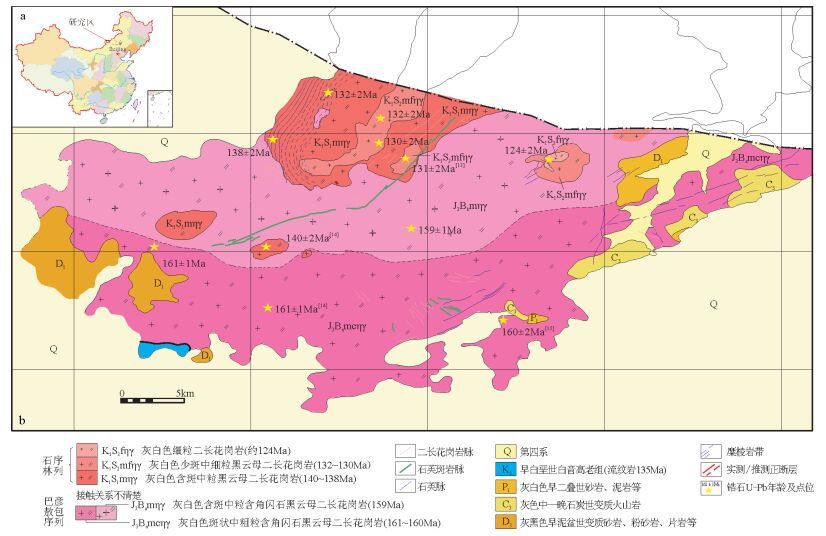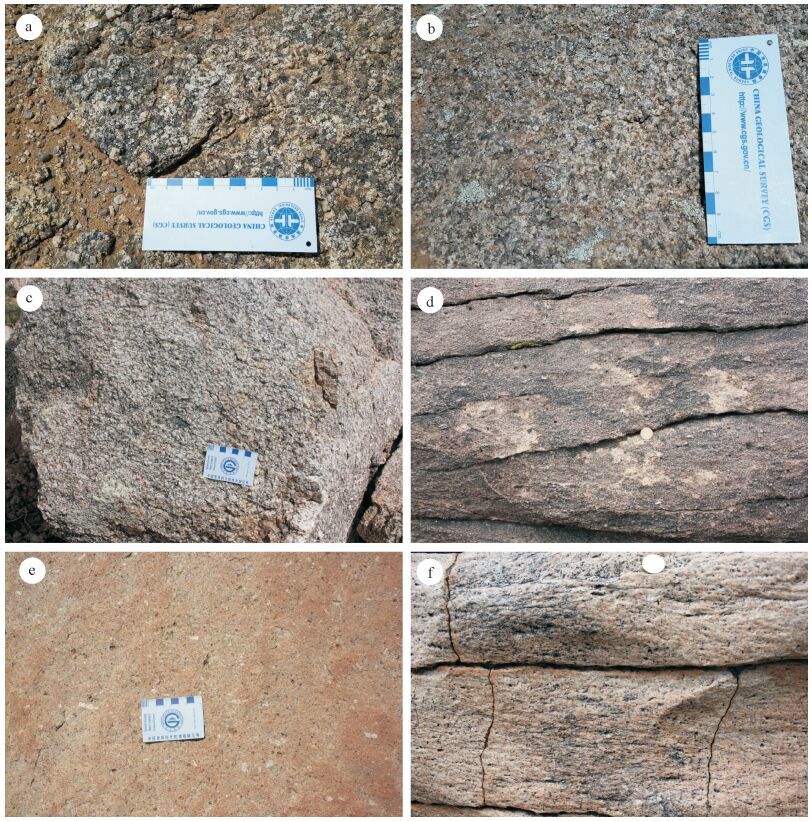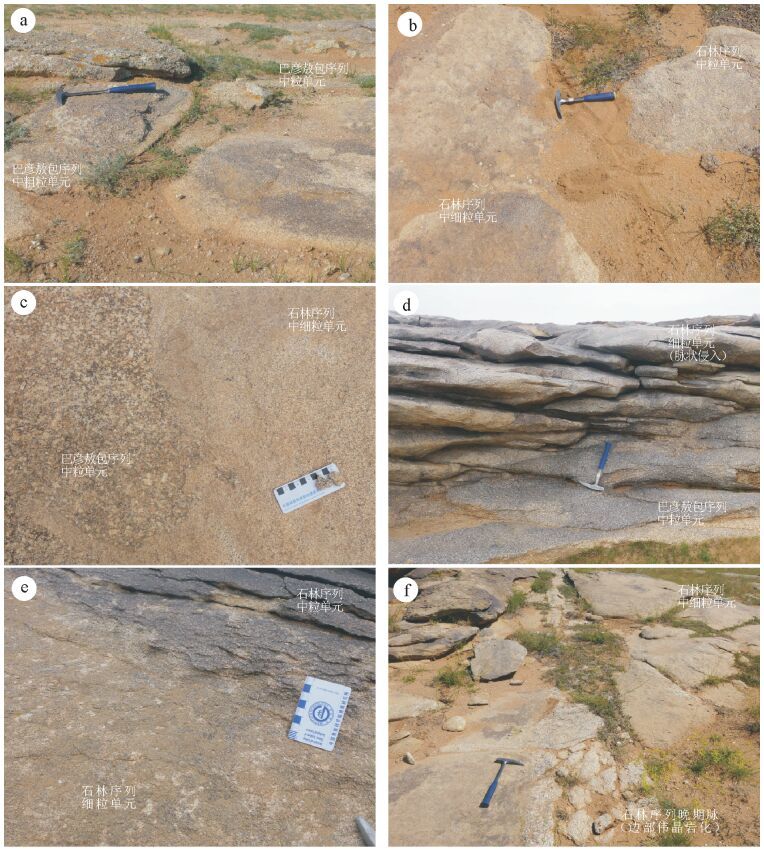Pedigree mapping of cogenetic granitoids:A case study of Baoder Stone Forest granitic pluton in Erlian, Inner Mongolia
-
摘要:
单元-超单元花岗岩谱系填图方法是以同源岩浆演化理论为指导思想建立发展的。该方法从20世纪80年代开始在中国推广和应用,然而,随着岩浆岩理论的不断发展及填图实践过程中遇到的问题,填图方法回归到早期的"岩性+时代"方法。在新的形势下,如何开展好新一轮的花岗岩填图工作,谱系填图是否仍具有适用性值得分析探讨。以中蒙边境地区出露的宝德尔石林花岗岩体填图试点成果为例,阐述岩浆岩填图试点方法的可行性。填图结果显示,该岩体为复式杂岩体,发育约160Ma和140~124Ma两期二长花岗岩,这两期二长花岗岩时代和岩石结构存在差别,野外的主要区别在于粒度。它们处于同一个区域性伸展背景,属于同源岩浆演化的产物。依据谱系划分方案,可以划分为晚侏罗世和早白垩世2个序列及5个单元,且可以进行区域对比。因此,基于岩浆演化规律,以解体岩体和进行岩石类型归并为精髓的谱系填图对于同源花岗岩仍是适用和必须的,但不可扩大化。
Abstract:Unit and superunit mapping has been popularized in China after the development of the cogenetic magma from the 1980s. However, more and more problems cropped out in the mapping practice with the development of the magma theory, and the early stage mapping method of "litholiogy plus epoch" was used again. Whether the application of pedigree mapping in the new stage geological mapping is suitable or not is worth discussing. The Baoder Stone Forest granitic pluton on the border area of Mongolia and China was selected to perform mapping. It is shown that the rock types in this pluton are complicated, including~160Ma coarsemiddle grained porphyritic hornblende biotite monzogranite and 140~124Ma middle-fine grained monzogranite. The rock types are similar, but there are differences in the intrusive ages and mineral structures of these monzogranites, and the main difference is the grain size. They formed in the same regional extensional background by the evolution of the cogenetic granitic magma. They can be divided into two sequences of the Late Jurassic and the Early Cretaceous, as well as five units. Pedigree mapping is still applicable and necessary for the cogenetic granitoids with similar ages and homologous origin, but it must be carefully used and do not expand to practical mapping of all granitoids.
-
Key words:
- congenetic granitoid /
- pedigree mapping /
- unit-superunit /
- mapping pilot /
- regional geological survey
-

-
表 1 花岗岩填图方法历史变化[1]
Table 1. Change of mapping method of granitoids
阶段 欧美 俄罗斯(前苏联) 中国 第一阶段
(20世纪50—70年代))岩性+时代 岩性+时代(岩相) 岩性+时代(岩相) 第二阶段
(20世纪80—90年代)单元-超单元-岩基段
组-序列
岩簇-岩套-超岩套侵入杂岩巨序列(巨岩套)-侵入杂岩序列(岩套)-侵入组合群(杂岩组合)-侵入体 单元-超单元-超单元组合侵入体 第三阶段
(20世纪90年代末—今)相对自由 标准不统一
多数回归岩性+时代岩性+时代 下一阶段
(讨论)单元-序列-超序列-超序列组合 -
[1] 嵩秉璋, 洪大卫, 郑基俭, 等.花岗岩类区1:5万区域地质填图方法指南[M].武汉:中国地质大学出版社, 1991:1-169.
[2] 洪大卫.有关花岗岩等级体制的分歧和争论[J].地质科技通报, 1991, (7):42-45. http://www.cqvip.com/QK/96865X/199107/463178.html
[3] 张昱, 丘顺帆. 1/5万地质填图中花岗岩单元、超单元的划分[J].黑龙江地质, 1994, 50(2):44-49. http://www.cqvip.com/Main/Detail.aspx?id=1372455
[4] 管运才, 吴海权.白马尖超单元组合特征及其成因机制[J].安徽地质, 1997, 7(2):26-35. http://kns.cnki.net/KCMS/detail/detail.aspx?filename=ahdz702.004&dbname=CJFD&dbcode=CJFQ
[5] 杨崇辉, 庄育勋, 王新社, 等.关于"侵入岩谱系单位填图方法"有关问题的讨论[J].地质论评, 2001, 47(5):483-486. http://d.wanfangdata.com.cn/Periodical/OA000006666
[6] 李永军, 赵仁夫, 刘志武, 等.关于造山带花岗岩类填图方法的讨论-以西秦岭天水地区为例[J].华南地质与矿产, 2003, 19:1-6. http://www.cnki.com.cn/Article/CJFDTotal-HNKC200301000.htm
[7] 王涛. 亚洲花岗岩及相关侵入岩(1: 500万)[EB/OL] [2013-12-06] http://www.igeodata.org/handle/20.500.11758/80.
[8] 胡道功, Patrick J B, 吴珍汉, 等.中美合作东昆仑造山带地质填图的启示:填图理念与填图方法[J].地质通报, 2009, 28(10):1411-1418. doi: 10.3969/j.issn.1671-2552.2009.10.007 http://dzhtb.cgs.cn/ch/reader/view_abstract.aspx?flag=1&file_no=20091007&journal_id=gbc
[9] 赵希涛, 胡道功, 吴中海.晚新生代地质填图理论与方法的新探索[J].地质通报, 2009, 28(10):1419-1429. doi: 10.3969/j.issn.1671-2552.2009.10.008 http://dzhtb.cgs.cn/ch/reader/view_abstract.aspx?flag=1&file_no=20091008&journal_id=gbc
[10] 李建星, Chen S F, 毛晓长, 等.中(西)澳地质填图对比及对中国地质填图的启示[J].地质通报, 2015, 34(12):2143-2149. doi: 10.3969/j.issn.1671-2552.2015.12.001 http://dzhtb.cgs.cn/ch/reader/view_abstract.aspx?flag=1&file_no=20151201&journal_id=gbc
[11] 王涛, 计文化, 胡建民, 等.专题地质填图及有关问题探讨[J].地质通报, 2016, 35(5):633-641. http://dzhtb.cgs.cn/ch/reader/view_abstract.aspx?flag=1&file_no=20160501&journal_id=gbc
[12] 肖庆辉.花岗岩研究思维与方法[M].北京:地质出版社, 2002:1-294.
[13] 陶继雄, 王弢, 陈郑辉, 等.内蒙古苏尼特左旗乌兰德勒钼铜多金属矿床辉钼矿铼-锇同位素定年及其地质特征[J].岩矿测试, 2009, 28(3):249-253. http://doi.wanfangdata.com.cn/10.3969/j.issn.0254-5357.2009.03.011
[14] 张阔, 孙丰月, 赵小亮, 等.内蒙古贺根山北乌兰德勒花岗岩体锆石U-Pb测年、地球化学特征及其构造意义[J].世界地质, 2013, 32(2):244-254. http://www.wenkuxiazai.com/doc/f5950d5ba76e58fafab003b7-3.html
[15] 薛富红, 张晓晖, 邓江夏, 等.内蒙古中部达来地区晚侏罗世A型花岗岩:地球化学特征、岩石成因与地质意义[J].岩石学报, 2015, 31(6):1774-1788. http://www.ysxb.ac.cn/ysxb/ch/reader/create_pdf.aspx?file_no=...
[16] Guo L, Tong Y, Wang T, et al. Evolution of extensional granitic domes in Baoder area and its tectonic implications. 2017(in review).
[17] 郭磊, 李建波, 童英, 等.内蒙古苏尼特左旗早白垩世宝德尔花岗岩伸展穹隆的确定及其地质意义[J].地质通报, 2015, 34(12):2195-2202. doi: 10.3969/j.issn.1671-2552.2015.12.006 http://dzhtb.cgs.cn/ch/reader/view_abstract.aspx?flag=1&file_no=20151206&journal_id=gbc
[18] Wang T, Guo L, Zhang L, et al. Timing and evolution of late Mesozoic granitoidmagmatisms in the Mongol-Okhotsk belt and its adjacent areas, NE Asia:implications for transition from contractional thickened to extensional thinning crust and geodynamic settings[J]. Journal of Asian Earth Sciences, 2015, 97(Part B, 1):365-392.
[19] Wang T, Tong Y, Zhang L, et al. Phanerozoic granitoids in the middle and eastern parts of Central Asia and their tectonic significance[J]. Journal of Asian Earth Sciences, 2017, 145:368-392. doi: 10.1016/j.jseaes.2017.06.029
[20] Wang T, Zheng Y D, Zhang J J, et al. Pattern and kinematic polarity of Late Mesozoic extension in continental NE Asia:Perspectives from metamorphic core complexes[J]. Tectonics, 2011, 30(6):6007-6033. https://www.researchgate.net/publication/235247287_Pattern_and...
[21] Wang T, Guo L, Zheng Y D, et al. Timing and processes of Late Mesozoic mid-lower-crustal extension in continental NE Asia and implications for the tectonic setting of the destruction of the North China Craton:Mainly constrained by zircon U-Pb ages from metamorphic core complexes[J]. Lithos, 2012, 154:315-345. doi: 10.1016/j.lithos.2012.07.020 https://www.sciencedirect.com/science/article/pii/S0024493712003027
[22] Davis G A, ZhengY, Wang C, et al. Mesozoic tectonic evolution of the Yanshan fold and thrust belt, with emphasis on Hebei and Liaoning provinces, Northern China[C]//Hendrix M S, Davis G A. Paleozoic and Mesozoic Tectonic evolution of Central Asia:from Continental Assembly to Intracontinental Deformation. Geol. Soc. Am. Mem., 2011, 194:71-197.
[23] 董树文, 张岳桥, 陈宣华, 等.晚侏罗世东亚多向汇聚构造体系的形成与变形特征[J].地球学报, 2008, 29(3):306-317. http://www.cqvip.com/QK/98325A/200803/27855295.html
[24] 吴福元, 杨进辉, 张艳斌, 等.辽西东南部中生代花岗岩的时代[J].岩石学报, 2006, 22(2):315-332. http://cpfd.cnki.com.cn/Article/CPFDTOTAL-DZDQ200702001064.htm
[25] Donskaya V, Windley B F, Mazukabzov A M, et al. Age and evolution of Late Mesozoic metamorphic core complexes in southern Siberia and northern Mongolia[J]. Journal of the Geological Society (London), 2008, 165(1):405-421. doi: 10.1144/0016-76492006-162 https://www.researchgate.net/profile/Alfred_Kroener2/publication...
[26] Guo L, Wang T, Castro A, et al. Petrogenesis and evolution of late Mesozoic granitic magmatism in the Hohhot metamorphic core complex, Daqing Shan, North China[J]. International Geology Review, 2012, 54(16):1885-1905. doi: 10.1080/00206814.2012.682778
[27] 王涛, 童英, 郭磊, 等.侵入岩填图方法体系及专题研究[J].地质通报, 2017, 36(11):1953-1662. http://dzhtb.cgs.cn/ch/reader/view_abstract.aspx?flag=1&file_no=20171106&journal_id=gbc
-




 下载:
下载:

